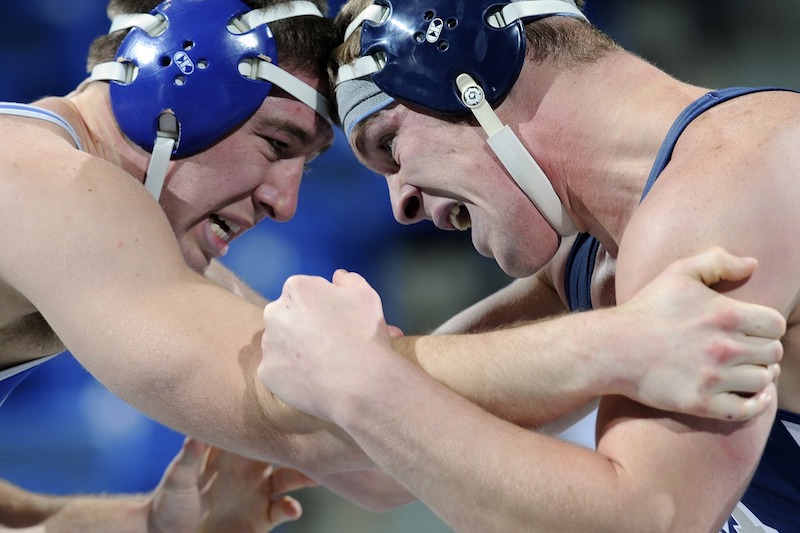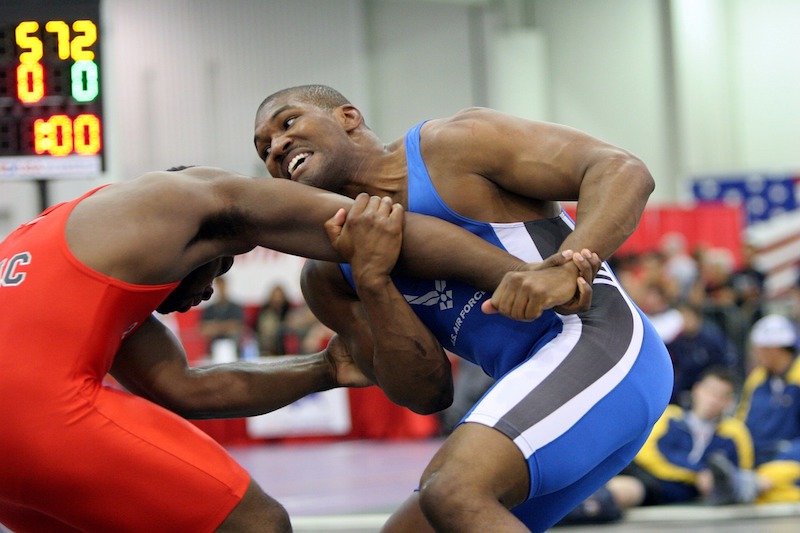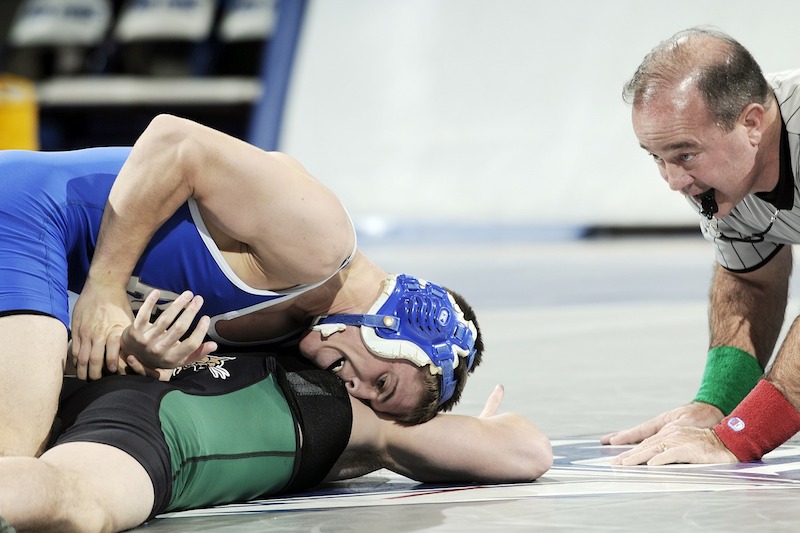The sport of wrestling is one of the oldest combat sports on record and was one of the first disciplines included in the ancient Olympic Games program. Wrestling was first highlighted in sport science research way back in 1943.(1) With such an extensive history as a sport and subject of sport science discovery, strength and conditioning coaches have a clear understanding of the physical needs of a wrestler.
Very few of the many studies analyzing the physical attributes of a wrestler are without mention of the need for explosive strength and power. More specifically, the studies aimed at differentiating the physical attributes of highly successful wrestlers vs. less successful wrestlers have noted as much as a 30% difference in power output measures between the elite and average wrestler.(2) While the culmination of many physical attributes is the best predictor of success, it is apparent that if you want to be a good wrestler, you better start understanding how to become more powerful.

Olympic weightlifting exercises such as the snatch, clean & jerk, and variations are unquestionably the favorite tool in a strength and conditioning coach’s toolbox for the development of lower body explosive power. This truth is no different in the sport of wrestling.
Iran is a powerhouse wrestling nation with a rich history of Olympic success. In 2014 researchers surveyed the training practices of wrestling specific strength and conditioning coaches within the Iranian Wrestling League (IWL). The survey found that Olympic-style lifts and their variations are the most frequently used exercises.(3) Additionally 97% of all coaches surveyed ranked speed and explosive power as the top two physical priorities in a wrestler’s training program. From a strength and conditioning coach’s perspective, this is not a surprise, since Olympic-style lifts have reliably benefitted athletes in an array of sports, and power has been characterized as the most critical aspect in sports training.(3) The inclusion of Olympic-style lifts in a wrestler’s training regimen extend beyond the development of maximal explosive power, but can additionally aid in the development of power endurance, and improve training economy if properly programmed.
[Ever thought strength sports should have more fighting? Here’s one author’s case for combat in fitness events.]
Developing Lower Body Maximal Power for Wrestlers
The lower body musculature is involved in almost every aspect of the sport of wrestling. As a ground-based sport, all movement while standing will originate at the hips, whether it be to maintain balance during hand fighting, sprawling to avoid a takedown, or penetrating deeply into a shot. Even when the match goes to the ground, the hips are being used to escape from the bottom or to control a competitor from the top position. The snatch, clean, and jerk tout some of the most impressive lower body power outputs of any sporting movements.(4)
The hip and knee extensors are the prime movers in these lifts, and also of critical importance to most dynamic wrestling maneuvers. Training using the Olympic-style lifts has been shown to improve speed and acceleration, which is of great benefit to effectively close the distance in a shot or quickly sprawl to avoid a takedown attempt.(5)(6)(7) Olympic-style lifts not only carry over to those high velocity tasks, but also maneuvers that require a heartier force production such as a throw. Training for maximal lower body power using the Olympic lifts is characterized by the use of high intensities (heavy loads) and low training volumes (limited number of sets and reps). Training intensity may from 85 to 100% of 1-rep maximums with volumes ranging from 1 to 5 sets of 1-3 repetitions. Full recovery between sets should be utilized to limit fatigue that will impair power and degrade technique.
[Looking for programming? Here’s one way almost any athlete can work in Olympic weightlifting.]
Power Endurance: A Big Piece of the Puzzle
Successful wrestlers need to be just as explosive and powerful at the end of a match as they are in the beginning. In a match, every wrestler is not only battling their competitor but also fatigue. At the onset of fatigue, movement speed and technical execution slows down and gets sloppy. A small deficit in ability may be all that an opponent needs to capitalize on lethargic actions and dominate the remainder of the match.
Power endurance is defined as the ability to perform powerful movements repetitively over an extended time.(8) For a wrestler, this means that their shots are just as quick, throws just as powerful, and sprawls just as effective at any point in the match. Traditionally, Olympic-style lifting prescription involves high intensities and low volumes, while maximizing recovery between sets to minimize fatigue. This approach will boost maximal power, but do little to prepare a grappler for the repetitive bouts of explosive action demanded in a match.
A power endurance protocol utilizing Olympic-style lifts is characterized by the use of lighter loads performed for higher volumes over pre-defined time intervals. Lansky successfully applied a protocol on wrestlers where they would perform one-repetition of an Olympic weightlifting movement every 5-10 seconds, for a one to three minute duration, with between a 75 and 20 second rest duration between sets.(9) As with all good programming, periodization of the training was used which started the athletes with longer durations between reps, shorter duration sets, and longer durations between sets and over time increased workload by decreasing duration between reps, lengthening set durations, and decreasing duration between sets. A power endurance strategy such as this simulates the nature of a match where wrestlers are faced with short strategic lulls while jockeying for position followed immediately by explosive maneuvering.
The short duration between repetitions and long duration of sets promotes the onset of fatigue while still demanding technically proficient and explosive execution by the athlete.
[Read more from the author: Why Olympic Weightlifting Improves Mixed Martial Artists.]
Training Economy
Wrestlers spend hours on the mat in practice, and generally have to fit in extra aerobic and anaerobic training sessions to meet their conditioning needs and energy expenditure requirements to maintain their weight class. This often leaves wrestlers time and energy depleted. Finding the time and energy to perform additional strength and power training sessions can be prohibitive.
Olympic-style lifts prescribed for maximal power or power endurance development are extremely economical. If training for maximal muscle power, training volumes can be as low as 2-3 sets of 1-3 repetitions which takes little time and energy to complete. The low training volume is also insufficient to induce high levels of Delayed Onset Muscle Soreness (DOMS) that will impede the quality of other training sessions throughout the week. Olympic-style lifts used in a manner to develop power endurance will be purposefully more fatiguing and time consuming, however training volumes are still likely to be lower than traditional strength and muscular endurance prescription, that can range anywhere from 3-5 working sets of 5-20 repetitions.
The technical aspect of the lifts serve as a built-in governor to manage fatigue. Degradation of technique due to fatigue will cause athletes to miss lifts, essentially putting an end to their training session. This threshold will be reached far sooner than traditional muscular endurance training where muscles can be taken to volitional fatigue leaving them extremely depleted of energy and sore. The predominantly concentric muscle actions used in Olympic-style lifts helps to mitigate the incidence of DOMS, despite higher training volumes, which is primarily attributed to eccentric muscle actions.
Wrapping Up
While a well-developed upper body musculature may look mighty intimidating in a singlet, the lower body musculature is really the workhorse for a wrestler. Being powerful in the hips and legs is critical for optimal execution of many of the fundamental wrestling actions such as shooting, sprawling, and takedowns. The most effective and economical means of developing lower body maximal power and power endurance is to incorporate Olympic-style lifts into strength and conditioning sessions. The lifts will not promote excessive muscular soreness, require much time or energy, and will undoubtedly make you more powerful.
References
1. Chaabene, H. et. al. (2017) Physical and Physiological Attributes of Wrestlers: An Update. Journal of Strength and Conditioning Research. May;31(5):1411-1442
2. García-Pallarés, J., López-Gullón, J.M., Muriel, X. et al. Physical fitness factors to predict male Olympic wrestling performance. Eur J Appl Physiol (2011) 111: 1747.
3. Far Saeed, Jamshidi & Mirzaei, Bahman & Damirchi, Arsalan. (2014). STRENGTH AND CONDITIONING PRACTICES OF IRAN Wrestling League STRENGTH AND CONDITIONING COACHES. Pedagogics, Psychology, Medical-Biological Problems of Physical Training and Sports.
4. Garhammer, J. (1980). Power production by Olympic weightlifters. Medicine and science in sports and exercise, 12(1), 54.
5. Suchomel, T. J., Comfort, P., & Stone, M. H. (2015). Weightlifting pulling derivatives: Rationale for implementation and application. Sports Medicine, 45(6), 823-839
6. Tack, Chris. (2013). Evidence-Based Guidelines for Strength and Conditioning in Mixed Martial Arts. Strength and Conditioning Journal: October 2013- Volume 35, Number 5, pages 79-92
7. Weyand, P. et. al. (2000). Faster top running speeds are achieved with greater ground forces not more rapid leg movements. Journal of Applied Physiology, Vol. 89, Issue 5 pg. 1991-1999
8. Ratamess, Nicholas. (2011) Strength and Conditioning for Grappling Sports. Strength and Conditioning Journal: December 2011 – Volume 33 – Issue 6 – p 18-24
9. Lansky, Richard. (1999) Wrestling and Olympic-Style Lifts: In-Season Maintenance of Power and Anaerobic Endurance. Strength and Conditioning Journal: June 1999- Volume 21, Number 3, pages 21–27



